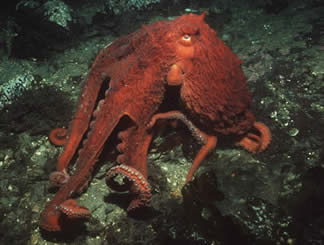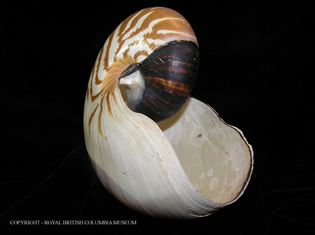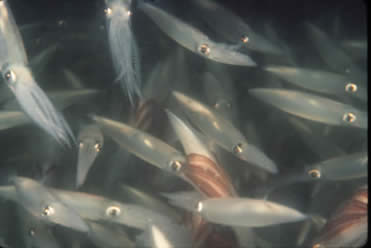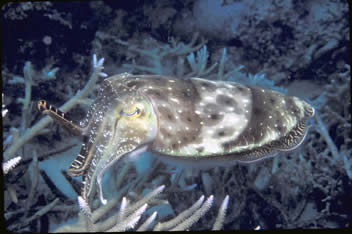

MOLLUSCS OF BRITISH COLUMBIA

Octopuses reach their largest size in the cool temperate waters of the north and south Pacific. Photo by James A. Cosgrove
Introduction to the Cephalopoda
by
James A. Cosgrove
The Phylum Mollusca is one of the largest and most diverse of the animal groups. It contains more than 35,000 extinct and 130,000 living species in what are currently recognized as 7 unequal Classes. The name Mollusca comes from the Latin word mollis (meaning soft). The word mollusc was first used by the French zoologist Cuvier in the late 1700’s to describe squids and cuttlefishes, members of the Class Cephalopoda. It was years later that the affinities between Cephalopods and the myriad of hard shelled animals such as clams and snails was recognized but by then the word mollusc was fixed and has remained to this day.
The Class Cephalopoda is one of the most interesting groups as it possesses some of the most highly evolved non-vertebrates in the world. The word cephalopod comes from the Greek and means head/foot. When one looks at a squid or an octopus we see a ring of appendages surrounding a mouth and a head attached. Most of the squids and cuttlefishes are classified as decapods (10 appendages of which 8 are arms and 2 are tentacles) while most octopuses are octopods (8 arms only, no tentacles).

Nautilus is the only modern cephalopod that has an external shell. It does not occur in BC.
Photo courtesy of the Royal BC Museum.
Cephalopods are all marine and can be found in all oceans from the surface to as deep as 7 kilometers. Some cephalopods are pelagic and never touch land while others are benthic and live on the bottom all their lives. There are also intermediate forms that have pelagic larval forms and benthic adult forms.
The cephalopods show a diversity of body forms. Some, such as nautilus and spirula, have external shells of calcium carbonate. The argonaut, however, produce a shell-like structure that is used to brood eggs in but the argonaut itself is a shell-less octopus. Cuttlefish have and internal skeleton called a “cuttlebone”. Squid also have a reduced internal skeleton of chitin called a “pen”. Octopuses have almost completely lost all skeletal elements and the only hard part in their body is the chitinous beak.

Mating Opal Squid (Loligo opalescens). Photo by James A. Cosgrove
Most cephalopods have a powerful saliva for digesting their meals and this may be injected into the food to partially digest the food before it is consumed. Many cephalopods also have venom (cephalotoxin) that is used to incapacitate the food. This venom, in groups such as the Blue Ring Octopus of Australia and New Zealand, has been fatal to humans.
Cephalopods have very short lives. Many of the smaller species will complete a full life cycle in less than 1 year. Even the largest of the pelagic squids have a life cycle of about 7 years. Many of the cephalopods are not well studied because they live at great depths and in the open ocean where research is very difficult and very expensive. For example, the first photos of a living Giant Squid (Architeuthis dux) in the wild were obtained in 2005 despite years of trying and millions of dollars being spent. One can understand how difficult it is for scientists to understand population dynamics or reproductive strategies in animals you only get to see when they wash up on shore or are caught by fishers. In most cases, cephalopods reproduce only once. When females reach sexual maturity they will mate and lay their eggs. In some cases (nautilus, squids and cuttlefishes) the adults die right away and the eggs are left to the mercy of the ocean. In other cases (octopuses) the female will stay and brood the eggs until she dies. In most cases the octopus eggs will hatch before the female dies but it varies from individual to individual. One must recognize that cephalopod fisheries takes only pre-reproductive animals and those heavy effort fisheries have significantly impacted cephalopod populations in some parts of the world.

Cuttlefish have an internal skeleton that is commonly used in bird cages.
Cuttlefish are not found in B.C. Photo by James A. Cosgrove
Cephalopods range in size from only a few grams to hundreds of kilograms.
One of the most impressive features of the cephalopods is their skins. Most have the ability to rapidly change the colour and texture of their skin to serve a number of functions including camouflage, mimicry, alarm displays and various forms of communication. Living cephalopods are amazing to watch and that is one of the reasons why they are so popular in marine exhibits and home aquariums. Many species are, however, very difficult to keep in captivity.
Diver and Octopus, photo by James A. Cosgrove
Please cite these pages as:
Author, date, page title. In: Klinkenberg, Brian. (Editor) 2023. E-Fauna BC: Electronic Atlas of the Fauna of British Columbia [www.efauna.bc.ca]. Department of Geography, University of British Columbia, Vancouver. [Date Accessed]
© Copyright 2023 E-Fauna BC.